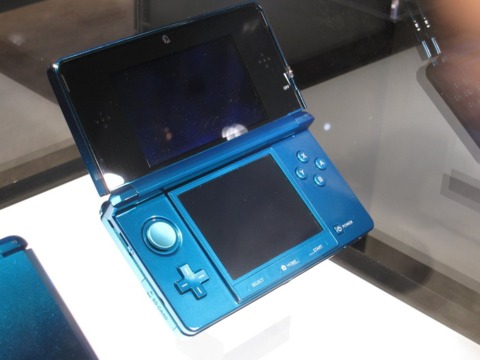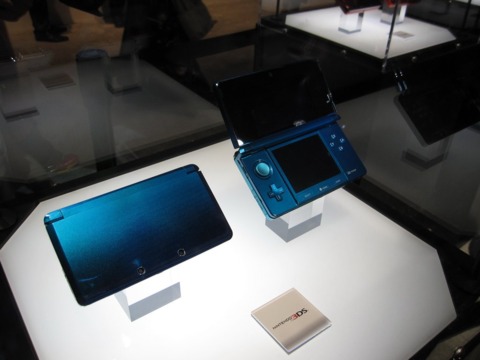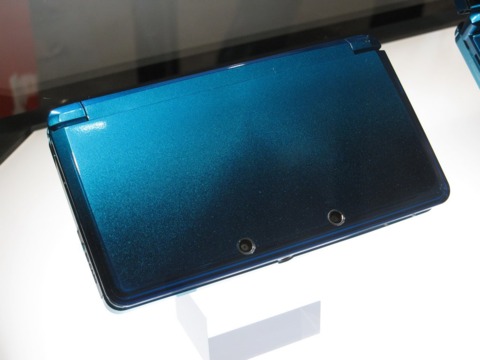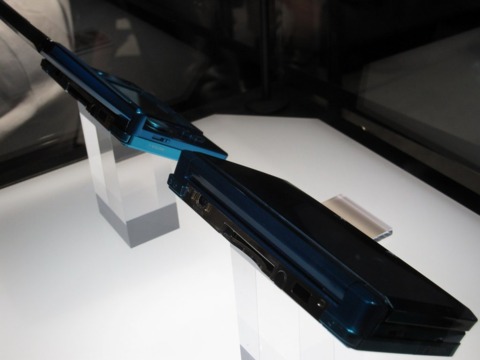Nintendo 3DS Hands-On Preview - Updated
Nintendo's 3DS is in short supply at E3, but we got our mitts on the machine.

After unceremoniously announcing the Nintendo 3DS in March, Nintendo pulled out all the stops at E3 2010. The console took up the latter portion of the company's keynote address and essentially accounts for the multi-hour-long lines at its booth. At the moment, the company has not announced a release date or pricing for the upcoming handheld console.
Screens
The biggest change to Nintendo's handheld platform is the addition of 3D without the need for glasses. Only the upper screen will be used to display 3D visuals. The bottom touch screen was tested for use as a 3D panel but was ultimately decided against, because the touch interactivity of the screen led to smudges that interfered with the 3D visuals. Depending on the game, some of the visuals do pop out of the screen, and there's a lot of depth to the point where you're tempted to reach into the game. However, this effect works only if you're staring at the right angle; otherwise, it will look distorted. The games we saw were designed to keep you in the sweet spot, although spectating friends might not be treated to a great show.
Kingdom Come: Deliverance 2 - Official Cinematic Announcement Trailer Stellar Blade - BIBI ‘Eve’ Official Music Video Trailer | PS5 Apex Legends: Urban Assault Collection Event Trailer Total War: WARHAMMER III - Elspeth von Draken Gameplay Showcase Genshin Impact - "Arlecchino: Sleep in Peace" | Official Character Teaser Potionomics: Masterwork Edition - Official Announcement Trailer Snowbreak: Containment Zone - "Gradient of Souls" Version Trailer Harold Halibut GameSpot Video Review Nancy Drew: Mystery of the Seven Keys | World Premiere Official Trailer Modern Warfare III & Warzone - Official Cheech & Chong Bundle Gameplay Trailer SteamWorld Heist II – Official Reveal Gameplay Trailer Dead Island 2 – Official SoLA Expansion Gameplay Launch Trailer
Please enter your date of birth to view this video
By clicking 'enter', you agree to GameSpot's
Terms of Use and Privacy Policy
Nintendo increased the size and resolution of the upper screen to 3.53 inches, and according to the official data sheet, the resolution of it is 800x240. If the resolution sounds odd, that's because it is. According to Nintendo, "400 pixels are allocated for each eye to enable 3D viewing." Nintendo didn't say much to explain the statement, but we speculate that there are actually two screens residing in the same spot, each visible at particular angles. As a result, each eye sees only 400 pixels of width, and doubling that gives us 800 pixels. The actual effective resolution would be 400x240, which also gives a more useful aspect ratio of 1.66, putting it between the standard 16:9 and 16:10 aspects.

The 3.02-inch touch screen on the bottom half received a bump up in resolution to 320x240 from the 256x192 LCD screen that's present on all current Nintendo DS models.
Internals
At the keynote address, Nintendo president Satoru Iwata indicated that the Nintendo 3DS would have an upgraded processor, but few details were given beyond that statement. The increased resolution of the upper screen--and if 3D rendering on the PC is to be taken as any indicator--lends further credence to the 3DS's beefier processor. Just doing the math, the Nintendo 3DS has to push 2.7 times the number of pixels as the Nintendo DS.
From our observations, the new version of Mario Kart looks particularly sharp. The karts and characters are as detailed as what you would find in Double Dash, and the 3D effect added to the items makes them pack even more of a punch. Flying around in Kid Icarus looked incredible. The clouds drift right into your eyes, and the enemies pop off the screen.
The Specifications
The Nintendo 3DS is still a work in progress, but the stats as of the moment put it at 5.3 inches wide x 2.9 inches long x .8 inches thick. By comparison, the Nintendo DSi is 5.4 inches wide x 2.95 inches long x .74 inches tall. Functionally, holding the Nintendo 3DS is pretty much the same as holding the DSi. We doubt the actual case size will change much between now and when the console launches.

Cameras
Nintendo added cameras to the DS platform when it released the Nintendo DSi. The 3DS takes the platform another step forward with the addition of two external cameras and one internal camera. Dual external cameras allow the 3DS to take 3D pictures. As with the DSi, the .3 megapixel (640x480) cameras found on the 3DS don't push the barrier in terms of overall image quality. Using the camera was dead simple, and the images it generated definitely looked like they were in 3D. The low resolution is clearly a limitation though, because the pictures looked blurry on the screen.
Controls
All the control mechanisms present on the DS made their way to the 3DS, but Nintendo also managed to add a few more along the way. New to the 3DS are motion sensors, a gyroscope, an analog stick (what Nintendo refers to as the "slide pad"), and a 3D depth slider that's used to adjust the 3D effect. The slider is there to adjust how much of a 3D effect you want to see. You can also opt to slide it to the bottom and view the screen in 2D. Nintendo also added a Home button to make getting back to the system menu easier.
The analog stick was nicely sized and made it easy to perform more subtle movements. We found it easy to make minor adjustments while playing, which translated to precision movements.
A retractable stylus is included and is much sturdier than the others that we're used to. It's made up of metal with plastic ends, so it looks like something you'd find from a Palm.

The implementation of motion controls that we saw didn't interfere with the 3D effect of the screen. Most of the demos we tried had us move the DS around in front of us, while the cameras added visuals to the graphics. We didn't see any examples of tilt-based gaming, or anything that would ruin the visuals. Face-Off, a tech demo, took a picture of us and then had us rotate the 3DS around our surroundings to shoot balloons with our faces rendered on them, all the while keeping the screens directly in front of us.
Wireless Connectivity
The Nintendo 3DS communicates wirelessly over 802.11 Wi-Fi and supports WPA and WPA2 security protocols. The big communications addition to the 3DS is more in how it communicates. Even while sleeping, the console will be able to hop onto the Internet to update rankings and quests and even download levels. Nintendo's Wii functions in a similar manner.
Ports
Nintendo gave the 3DS the ability to run both DS and 3DS games using a single slot. We didn't get to see what 3DS cartridges look like, but we're interested to learn how Nintendo will differentiate them to prevent consumer confusion. Like the DSi, the 3DS has an SD memory card slot. In addition to the stereo headphone jack, there's a charging cradle terminal.
Battery Life
Nintendo didn't have an official battery life estimate, but at a Q&A session, we did find out that Nintendo expects the 3DS to have battery life similar to the Nintendo DSi.
We'll have more information rolling in throughout the show, so be sure to check back. If there's anything you're curious about, leave us a note in the comments, and we'll do our best to get an answer.
Got a news tip or want to contact us directly? Email news@gamespot.com
Join the conversation